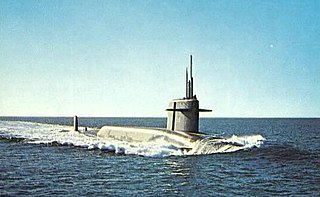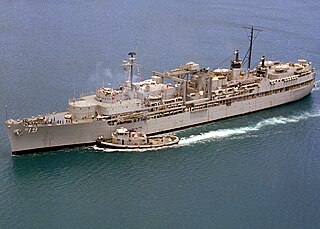
USS Patrick Henry (SSBN-599), named after the American Revolutionary War figure and Founding Father Patrick Henry (1736–1799), was a George Washington class nuclear-powered fleet ballistic missile submarine of the United States Navy. She was later converted into an attack submarine and redesignated SSN-599.

USS Theodore Roosevelt (SSBN-600), a George Washington-class submarine, was the second ship of the United States Navy to be named for President Theodore Roosevelt (1858–1919). Initially unnamed and assigned hull classification symbol SSGN-600 as a guided missile submarine, her keel was laid down on 20 May 1958 by the Mare Island Naval Shipyard using components initially assembled for the Skipjack-class submarine nuclear attack submarine USS Scamp (SSN-588). She was named Theodore Roosevelt and redesignated fleet ballistic missile submarine SSBN-600 on 6 November 1958, launched on 3 October 1959, sponsored by Alice Roosevelt Longworth, daughter of Theodore Roosevelt and widow of Nicholas Longworth III, and commissioned on 13 February 1961 with Commander William E. Sims commanding the Blue Crew and Commander Oliver H. Perry, Jr. commanding the Gold Crew.

USS Robert E. Lee (SSBN-601), a George Washington-class fleet ballistic missile submarine, was the only ship of the United States Navy to be named for Robert E. Lee (1807–1870), the commanding general of the Confederate forces during the American Civil War.

USS Abraham Lincoln (SSBN-602), a George Washington-class fleet ballistic missile submarine, was the second ship of the United States Navy to be named for Abraham Lincoln, the 16th President of the United States (1861–1865), the first being USS President Lincoln (1907).

USS Sam Houston (SSBN-609/SSN-609), an Ethan Allen-class submarine, was the second ship of the United States Navy to be named after Sam Houston (1793–1863), president of the Republic of Texas. Sam Houston was the US Navy's seventh ballistic missile submarine.

USS Thomas A. Edison (SSBN-610), an Ethan Allen-class nuclear-powered ballistic missile submarine, was the second ship of the United States Navy to be named for the inventor Thomas Edison (1847–1931).

USS Alexander Hamilton (SSBN-617) was a United States Lafayette-class ballistic missile submarine. It was the third ship of the United States Navy to be named for Founding Father Alexander Hamilton, the first US Secretary of the Treasury, who was instrumental in the formation of both the United States Coast Guard and the United States Navy.

USS Nathanael Greene (SSBN-636), a James Madison-class fleet ballistic missile submarine, was the third ship of the United States Navy to be named for Major General Nathanael Greene (1746–1786), who served in the Continental Army during the American Revolutionary War.a

The third USS Proteus (AS-19) was a Fulton-class submarine tender in the United States Navy.

USS Betelgeuse (AK-260) was the last of the cargo ships in service in the United States Navy. On 10 April 1944, it was renamed the SS Colombia Victory after being launched as a Victory ship to carry cargo during World War II. She was transferred to the US Navy in 1951.

ABSD-7, an advanced base sectional dock, was constructed of seven advance base docks (ABD) as follows: ABD-37, ABD-38, ABD-39, and ABD-40 were built by Chicago Bridge & Iron Company, Morgan City, Louisiana, and completed in December 1944 and January and February 1945; ABD-51 and ABD-52 were built by Pollock-Stockton Shipbuilding Company, Stockton, California, and completed in January and March 1945; and ABD-58 was built by Pittsburgh-Des Moines Steel Co., Pittsburgh, Pennsylvania, and completed in October 1944.

USS Woodrow Wilson (SSBN-624), a Lafayette class ballistic missile submarine, was the only ship of the United States Navy to be named for Woodrow Wilson (1856–1924), the 28th President of the United States (1913–1921). She later was converted into an attack submarine and redesignated SSN-624.

USS Kamehameha (SSBN-642) was a Benjamin Franklin-class ballistic missile submarine and the only ship in the United States Navy to be named after Kamehameha I, the first King of Hawaii. She is one of only two United States ships named after a monarch.a She was later reclassified as an attack submarine and re-designated SSN-642.

USS Tecumseh (SSBN-628), a James Madison-class ballistic missile submarine, was the fourth ship of the United States Navy to be named for Tecumseh (c.1768–1813), the leader of the Shawnee people.

USS Casimir Pulaski (SSBN-633), a James Madison-class ballistic missile submarine, was the second ship of the United States Navy to be named for Casimir Pulaski (1745–1779), a Polish general who served in the American Revolutionary War.

USS Stonewall Jackson, a James Madison-class fleet ballistic missile submarine, was the third ship of the United States Navy to be named for Confederate States Army General Thomas J. "Stonewall" Jackson (1824–1863).a

USS Simon Lake (AS-33) was the lead ship of her class of submarine tenders in the United States Navy, named for Simon Lake, a pioneering designer of early submarines.

USS Canopus (AS-34) was a Simon Lake-class submarine tender of the United States Navy, operational from 1965 to 1994. The vessel was used to repair and refit submarine-launched Polaris nuclear-armed ballistic missiles and the submarines that deployed with them. The vessel primarily served US naval bases on the US Atlantic Coast and in Europe. In 1969, the ship was overhauled to maintain the new Poseidon Missile Systems. Taken out of service in 1995, the US Navy's intent to have the ship broken up for scrap in the United Kingdom was controversial. By 2010 demolition had been completed.

USS Holland was a submarine tender in service with the United States Navy from 1963 to 1996.

Submarine Squadron 15 is a squadron of submarines of the United States Navy based at Naval Base Guam.






















